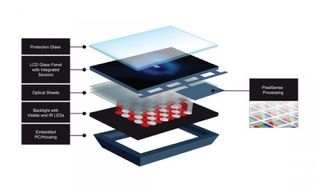Clearing a path: why we aren't using transparent phones
Can see-through screens break out of sci-fi and into our hands?
The technical barriers don't appear to be insurmountable, but beyond the fact that translucent smartphone or tablet concepts look really cool, are there actually any practical benefits?
"We asked ourselves: what are these devices really good for?" explains Dr. Juan David Hincapié-Ramos, from the University of Manitoba, "They're impressive aesthetically, and there are lots of concepts in science fiction or design competitions suggesting what transparent display should be good for, but they are no more than concepts."
"What we set out to do was actually build a device and realise a lot of the potential interactions, but also have a look at how everyday tasks could benefit from this technology."
The result was the tPad, a transparent display tablet prototype that the researchers built themselves using LCD displays with low-opacity filters.
Before moving on to the search for a killer application they looked at some ways that transparent displays could benefit us, taking into account how we use tablets and smartphones today.
"Task switching and picture capture are better with transparent displays," was an option suggested by Hincapié-Ramos.
The idea behind task switching is that you could have different apps running on each side of the display.
Get daily insight, inspiration and deals in your inbox
Get the hottest deals available in your inbox plus news, reviews, opinion, analysis and more from the TechRadar team.
Imagine you're browsing the web on your smartphone and a message comes in, if you simply flip the device to deal with your incoming message and then flip back when you're done, it's easier and quicker to continue with your task.
Another potential benefit the research turned up was the idea of overlaying the phone or tablet on something you want to take a picture of, such as a business card or a book.
They found this kind of "surface capture" was quicker and easier than trying to frame a shot with a traditional smartphone camera.
Augmented reality reveals more
One potential killer app for transparent displays is augmented reality; another technology that has been seemingly slow to really take off in recent years, but there are issues to overcome: namely two things called colour blending and binocular parallax.
"The quality of the image is affected by whatever is in the background because colours blend with it. If you have a uniform surface behind the display then it works, if not then you're going to struggle to distinguish what's what." explains Hincapié-Ramos.
Binocular parallax is about our perception of content alignment with augmented reality and can impact on depth perception, making it difficult to interact.
The solution they came up with is called "Contact Augmented Reality" which involves placing your device directly on top of the object that you are augmenting. It would allow the object itself to trigger AR content on the device, so there would be no need to open an app first.

Microsoft's PixelSense table top shows some of the potential in its ability to recognise and interact with certain objects when they are placed on the screen, but this technology is not available in transparent displays yet.
When will we see transparent phones on the market?
There are still some fundamental challenges to overcome. Manufacturers embed all the electronics in smartphones and tablets behind the screen.
Transparent displays don't make fully transparent devices and so we need to miniaturize components further and create form factors that deliver the potential benefits and aesthetic appeal of transparent displays without compromising on functionality.
"The display not only has to be transparent," says Hincapié-Ramos, "the display also has to be a sensor."
As far as the technology has come, it also still can't compete with the colour quality of the displays in current smartphone flagships.
In order to achieve colour and transparency in the tPad project they had to modify a display with a low-opacity back filter and use white light in the background.
This need for an external light source is still a major stumbling block for our prospects of seeing a truly transparent smartphone or tablet in the near future.
With companies like LG Display and Samsung already working on the technical feasibility, and researchers like Hincapié-Ramos identifying potential applications, transparent displays are still a hot enough topic to believe they will appear in the future.
But while an interactive window could appear down the highstreet, there's still one major issue left to be solved before we get the transparent smartphone: why would we want it?
